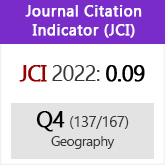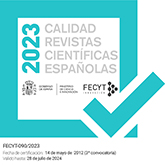Beneficios y costes ambientales en la Directiva Marco del Agua: conceptos y estimación
DOI:
https://doi.org/10.3989/estgeogr.0416Palabras clave:
Directiva Marco del Agua, costes y beneficios ambientales, costes desproporcionadosResumen
Dentro del análisis económico que la Directiva Marco del Agua (DMA) prescribe para alcanzar una gestión sostenible de los recursos hídricos, destaca la necesidad de evaluar los beneficios y costes ambientales. Dada la falta de una definición explícita de estos conceptos en el texto de la Directiva y, al mismo tiempo, la necesidad acuciante de evaluar la desproporcionalidad de los costes de la implementación de la DMA, este artículo pretende contribuir a la reflexión sobre los conceptos de beneficio y coste ambiental en este contexto. Se discuten la diferentes interpretaciones y valoraciones que se han hecho hasta el momento en Europa y se profundiza en aspectos claves para su estimación.
Descargas
Citas
Álvarez-Farizo, B.; Hanley, N.; Barberán, R. y Lázaro, A. (2006): “Choice Modelling at the ‘Market Stall’: Individual versus Collective Interest in Environmental Valuation”, Ecological Economics.
Álvarez-Farizo, B. y Hanley, N. (2006): “Improving the Process of Valuing Non-Market Benefits: Combining Citizens Juries with Choice Modelling”, Land Economics, vol. 82, nº 3, pp. 465-478.
Andreu, J.; Pulido, M.; Collazos, G. y Pérez, M. A. (2006): Metodologías y Herramientas para el Análisis Económico de Sistemas y Recursos Hídricos. Aplicación a la DMA, Fundación Nueva Cultura del Agua (Editor), Congreso Ibérico sobre gestión y planificación del agua.
Arnstein, S. R. (1969): “A Ladder of Citizen Participation”, Journal of the American Institute of Planners, 35, pp. 216-224. doi:10.1080/01944366908977225
Azqueta, D. y Delacámara, G. (2006): “Ethics, Economics and Environmental Management”, Ecological Economics, vol. 56, nº 4, pp. 524-533. doi:10.1016/j.ecolecon.2005.03.003
Baker, B.; Metcalfe, P.; Butler, S. et al. (2007): Report on the Benefits of Water Framework Directive Programmes of Measure in England and Wales, DEFRA, Reino Unido.
Bateman, I. J.; Carson, B. y Day, B. H. (2002): Economic Valuation with Stated Preference Techniques: Summary Guide, Edgar Elgar, Massachussets.
Bateman, I. J.; Brouwer, R.; Davies, H.; Day, B. H.; Deflandre, A.; Falco, S. D.; Georgiou, S.; Hadley, D.; Hutchins, M.; Jones, A. P.; Kay, D.; Leeks, G.; Lewis, M.; Lovett, A. A.; Neal, C.; Posen, P.; Rigby, D. y Kerry Turner, R. (2006a): “Analysing the Agricultural Costs and Non-market Benefits of Implementing the Water Framework Directive”, Journal of Agricultural Economics, 57, pp. 221-237. doi:10.1111/j.1477-9552.2006.00049.x
Bateman, I. J.; Day, B. H.; Georgiou, S. y Lake, I. (2006b): “The Aggregation of Environmental Benefit Values: Welfare Measures, Distance Decay and Total WTP”, Ecological Economics, 60: 450-460. doi:10.1016/j.ecolecon.2006.04.003
Birol, E.; Karousakis, K. y Koundouri, P. (2006): “Using Economic Valuation Techniques to Inform Water Resources Management: A Survey and Critical Appraisal of Available Techniques and an Application”, Science of the Total Environment, 365, pp. 105-122. doi:10.1016/j.scitotenv.2006.02.032 PMid:16647102
Bockstael, N. (1996): “Modelling Economics and Ecology: the Importance of a Spatial Perspective”, American Journal of Agricultural Economics, vol. 78, December, pp. 1168-1180. doi:10.2307/1243487
Brody, S. D. y Highfield, L. A. (2004): “Does Location Matter? Measuring Environmental Perceptions of Creeks in Two San Antonio Watersheds”, Environment and Behaviour, 36, pp. 229-250. doi:10.1177/0013916503256900
Brouwer R. (2006a): Assessment of Environmental and Resource Cost in the Water Framework Directive, International Workshop on Hydro-economic Modelling and Tools for Implementation of the EU Water Framework Directive, Valencia.
Brouwer R. (2006b): “Valuing Water Quality Changes in the Netherlands using Stated Preference Methods”, en DW Pearce (ed.), Valuing the environment in Developed Countries, Edward Elgar Publishing, Cheltenham, Reino Unido.
Brouwer, R. y Georgiou, S. (2007): Economic Valuation of Environmental and Resources Costs and Benefits of Water Uses and Services in Water Framework Directive: Technical Guidelines for Practitioners, EU 6th FP AquaMoney Project: Development and Testing of Practical Guidelines for the Assessment of Environmental and Resource Costs and Benefits in the WFD: www.aquamoney.org
Brouwer, R. (2008): “The Role of Stated Preference Methods in the Water Framework Directive to Assess Disproportionate Costs”, Journal of Environmental Planning and Management, 51(5), pp. 597-614. doi:10.1080/09640560802207860
Carson, R. T. y Mitchell, R. (1993): “The value of clean water: the public's willingness to pay for boatable, fishable and swimmable quality water”, Water Resources Research, 29, p. 2445. doi:10.1029/93WR00495
Carson, R. T. (1997): Contingent Valuation Surveys and Tests of Insensitivity to Scop, en Kopp, R. J.; Pommerhene, W. y Schwartz, N. (eds.), Determining the Value of Non-marketed Goods: Economic, Psychological and Policy Relevant Aspects of Contingent Valuation Methods, Kluwer, Boston, pp. 127-163.
Carson, R. T.; Flores, N. E. y Meade, N. F. (2001): “Contingent Valuation: Controversies and Evidence”, Environmental and Resource Economics, 19, p. 173-210. doi:10.1023/A:1011128332243
Comisión Europea (2003a): Economics and the Environment: The implementation Challenge of the Water Framework Directive, A Guidance Document, WATECO.
Comisión Europea (2003b): Guidance Document nº 8, Public Participation in Relation to the Water Framework Directive. Common Implementation Strategy for the Water Framework Directive, Bruselas.
Comisión Europea (2003c): Overall approach for the classification of Ecological Status and Ecological Potential, Office for Official Publications of the European Commission, Luxemburg.
Costanza, R. (1989): “What is Ecological Economics?”, Ecological Economics, 1, p. 1. doi:10.1016/0921-8009(89)90020-7
Costanza R.; D'Arge, R.; Groot, R.; Farber, S.; Grasso, M.; Hannon, B.; Limburg, K.; Naeem, S.; O'Neil, R.; Paruelo, J.; Raskin, R.; Sutton, R. y Van den Belt, M. (1997): “The Value of the World's Ecosystem Services and Natural Capital”, Nature, 387, pp. 253-260. doi:10.1038/387253a0
Cummings R. G.; Brookshire, D. S. y Schulze, W. D. (1993): Valuing environmental goods: an assessment of the contingent valuation method, Rowman and Allanheld, Totowa.
Eade, J. D. O. y Moran, D. (1996): “Spatial Economic Valuation: Benefits Transfer using Geographical Information Systems”, Journal of Environmental Management, vol. 48, nº 2, pp. 97-110. doi:10.1006/jema.1996.9990
ENCOBALT (2007): Valuing environmental costs and benefits for supporting the implementation of the WFD in the Baltic Member States.
Ferrer, G. y La Roca, F. (2006): El papel de la economía en el desarrollo e implementación de la Directiva Marco del Agua. Ambigüedad conceptual y problemas prácticos, Universidad de Valencia, Mimeo.
Freeman, A. M. I. (1979): The benefits of environmental improvement: Theory and practice, The John Hopkins University Press, Publisher.
Gómez, C. M. (2006): Los costes y beneficios ambientales en el proceso de decisión de la DMA, Hydronomic Convention, Barcelona.
González-Antón, C. y Arias, C. (2001): “The Incorporation of Integrated Management in European Water Policy”, Integrated Water Resources Management, IAS Press, Oxfordshire, pp. 69-74.
Görlach, B. e Interwies, E. (2006). “Assessing Environmental and Resource cost in the Water Framework Directive: the Case of Germany”, Ecologic, Institut für Internationale und Europäische Umweltpolitik, Berlín.
Green, C. (2003): Water Economics, Principles and Practice, Wiley, West Sussex. Hanemann, W. M. (1991): “Willingness to Pay and Willingness to Accept: How Much Can They Differ?”, The American Economic Review, 81, pp. 635-647.
Hanley, N.; Wright, R. y Álvarez-Farizo, B. (2006a): “Estimating the economic value of improvements in river ecology using choice experiments: an application to the water framework directive”, Journal of Environmental Management, 78, pp. 183-193. doi:10.1016/j.jenvman.2005.05.001 PMid:16112797
Hanley, N.; Colombo, S.; Tinch, D.; Black, A. y Aftab, A. (2006b): “Estimating the Benefits of Water Quality Improvements under the Water Framework Directive: are Benefits Transferable?”, Eur Rev Agric Econ, 33, pp. 391-413. doi:10.1093/eurrag/jbl019
Heberling, M.; Fisher, A. y Shortle, J. (2000): How the number of choice steps affects responses in stated choice surveys, US EPA, Cincinnati.
Hein, L.; van Koppen, K. R.; De Groot, R. S. y van Ierland, E. C. (2006): “Spatial Scales, Stakeholders and the Valuation of Ecosystem Services”, Ecological Economics, vol. 57, nº 2, pp. 209-228. doi:10.1016/j.ecolecon.2005.04.005
Interwies, E.; Kraemer, A.; Kranz, N.; Görlach, B. y Dworak, T. (2004): Basic Principles for Selecting the Most Cost-Effective Combinations of Measures for Inclusion in the Programme of Measures as Described in Article 11 of the Water Framework Directive, Handbook, German Federal Environmental Agency, Berlín.
Johnston, R. J.; Swallow, S. K. y Bauer, D. M. (2002): “Spatial Factors and Stated Preference Values for Public Goods: Considerations for Rural Land Use”, Land Economics, vol. 78, pp. 481-500. doi:10.2307/3146848
Knetsch, J. L. y Sinden, J. A. (1984): “Willingness to Pay and Compensation Demanded: Experimental Evidence of an Unexpected Disparity in Measures of Value”, The Quarterly Journal of Economics, 99, pp. 507-521. doi:10.2307/1885962
Loomis, J. B. (2000): “Environmental Valuation Techniques in Water Resources Decision Making”, Journal of Water Resources Planning and Management, pp. 339-344. doi:10.1061/(ASCE)0733-9496(2000)126:6(339)
Martínez Alier, J. y Roca Jusmet, J. (2000): Economía Ecológica y Política Ambiental, Fondo de Cultura Económica, México.
Ministerio de Medio Ambiente y Gobierno de Navarra (2002): Análisis Económico del Plan de Cuenca del Cidacos, Aplicación de la Guía de Análisis Económico de la Directiva Marco del Agua.
Moral Ituarte, L. (1994): “Elementos para una teoría de los conflictos territoriales sobre el agua”, Boletín de la A.G.E., 18, pp. 17-27.
Moral Ituarte, L. (2001): “El tratamiento del agua en la ordenación del territorio. Consideraciones sobre su concreción en Andalucía”, Scripta Veterea, 81.
Naciones Unidas (2003): Informe sobre el desarrollo de los recursos hídricos en el mundo: agua para todos, agua para la vida.
Pearce, D. W. y Turner, R. K. (1995): Economía de los recursos naturales y el medio ambiente, Colegio de Economistas de Madrid, Madrid.
Piñero Campos, J. M. (2004): “La Transposición de la Directiva Marco de las Aguas al Derecho Español”, Jornadas sobre La Aplicación de la Directiva Marco del Agua, Colegio de Ingenieros de Caminos Canales y Puertos, Madrid.
Postle, M.; Foottit, A.; Fenn, T. y Salado, R. (2004): CEA y Developing a Methodology for Assessing Disproportionate Costs, Department for Environment, food y Rural Affairs (DEFRA), Reino Unido.
Romero, C. (1994): Economía de los Recursos Ambientales y Naturales, Alianza Economía, Madrid.
Schaafsma, M. y Brouwer, R. (2006): “Overview of Existing Guidelines and Manuals for the Economic Valuation of Environmental Costs and Benefits”, EU 6th FP AquaMoney Project: Development and Testing of Practical Guidelines for the Assessment of Environmental and Resource Costs and Benefits in the WFD: www.aquamoney.org
Strosser, P. (2006): Assessing environmental costs in the context of the implementation of the European Union Framework Directive, Barcelona.
UNESCO (2002): 21st Century Talks, París.
Unión Europea (2000): Directiva 2000/60/CE por la que se Establece el Marco Comunitario de Actuación en Política de Agua.
Wesley A. M.; Joel, H.; Viscusi, W. K. y Jason, B. (2000): “An Iterative Choice Approach to Valuing Clean Lakes, Rivers, y Streams”, Journal of Risk and Uncertainty, vol. 21, pp. 7-43. doi:10.1023/A:1026565225801
Wittmer, H.; Rauschamyer, F. y Klauer, B. (2006): “How to Select Instruments for the Resolution of Environmental Conflicts?”, Land Use Policy, 23, pp. 1-9. doi:10.1016/j.landusepol.2004.09.003
World Wide Fund for Nature and European Bureau (2006): Survey of the economic elements of the Article 5 report of the EU Water Framework Directive, Bruselas.
Wright, S. A. L. (2007): Decision-making in the European Water Framework Directive: the potential consequences of the neoclassical approach, Informe 5.958.473, Facultad de Ciencias de la Vida, Universidad de Copenhague: www.forskiningsdatabasen.dk
Descargas
Publicado
Cómo citar
Número
Sección
Licencia
Derechos de autor 2008 Consejo Superior de Investigaciones Científicas (CSIC)

Esta obra está bajo una licencia internacional Creative Commons Atribución 4.0.
© CSIC. Los originales publicados en las ediciones impresa y electrónica de esta Revista son propiedad del Consejo Superior de Investigaciones Científicas, siendo necesario citar la procedencia en cualquier reproducción parcial o total.Salvo indicación contraria, todos los contenidos de la edición electrónica se distribuyen bajo una licencia de uso y distribución “Creative Commons Reconocimiento 4.0 Internacional ” (CC BY 4.0). Puede consultar desde aquí la versión informativa y el texto legal de la licencia. Esta circunstancia ha de hacerse constar expresamente de esta forma cuando sea necesario.
No se autoriza el depósito en repositorios, páginas web personales o similares de cualquier otra versión distinta a la publicada por el editor.
















